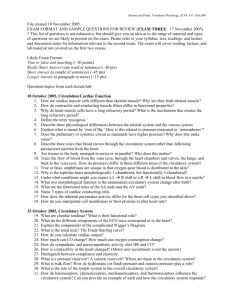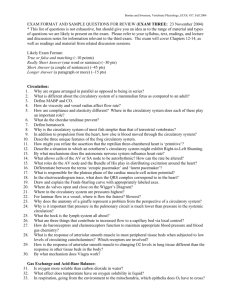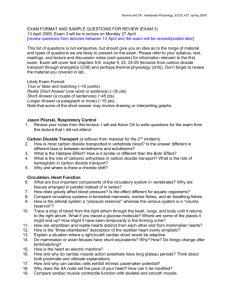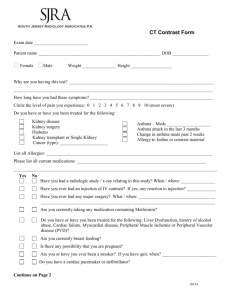2008 Review Questions
advertisement
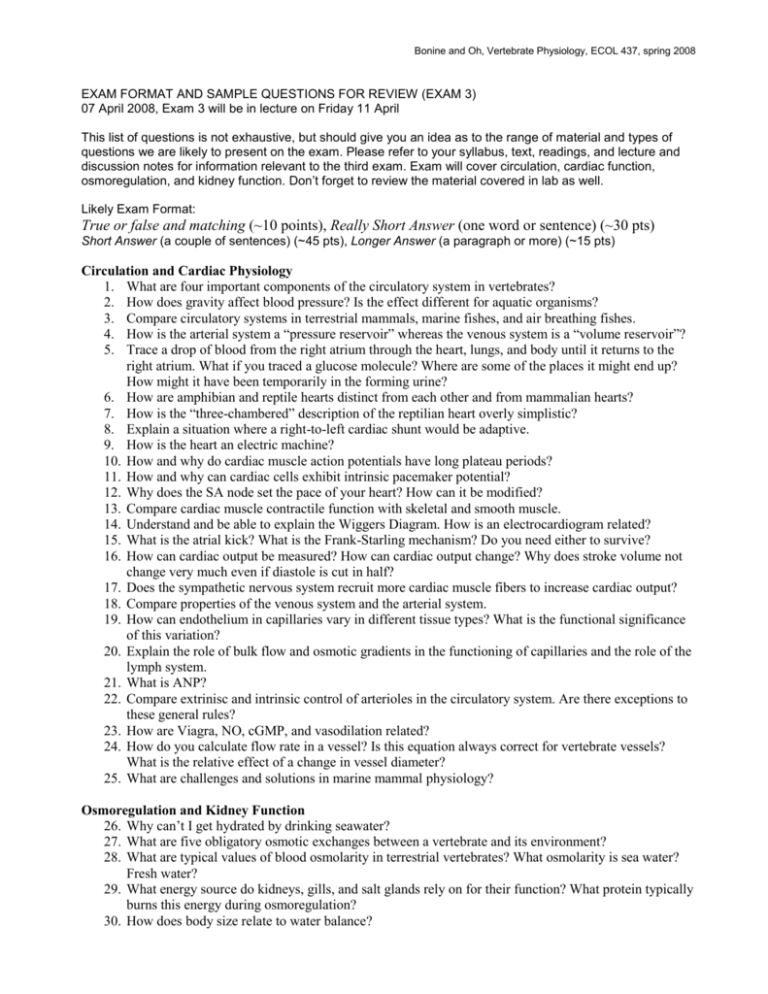
Bonine and Oh, Vertebrate Physiology, ECOL 437, spring 2008 EXAM FORMAT AND SAMPLE QUESTIONS FOR REVIEW (EXAM 3) 07 April 2008, Exam 3 will be in lecture on Friday 11 April This list of questions is not exhaustive, but should give you an idea as to the range of material and types of questions we are likely to present on the exam. Please refer to your syllabus, text, readings, and lecture and discussion notes for information relevant to the third exam. Exam will cover circulation, cardiac function, osmoregulation, and kidney function. Don’t forget to review the material covered in lab as well. Likely Exam Format: True or false and matching (~10 points), Really Short Answer (one word or sentence) (~30 pts) Short Answer (a couple of sentences) (~45 pts), Longer Answer (a paragraph or more) (~15 pts) Circulation and Cardiac Physiology 1. What are four important components of the circulatory system in vertebrates? 2. How does gravity affect blood pressure? Is the effect different for aquatic organisms? 3. Compare circulatory systems in terrestrial mammals, marine fishes, and air breathing fishes. 4. How is the arterial system a “pressure reservoir” whereas the venous system is a “volume reservoir”? 5. Trace a drop of blood from the right atrium through the heart, lungs, and body until it returns to the right atrium. What if you traced a glucose molecule? Where are some of the places it might end up? How might it have been temporarily in the forming urine? 6. How are amphibian and reptile hearts distinct from each other and from mammalian hearts? 7. How is the “three-chambered” description of the reptilian heart overly simplistic? 8. Explain a situation where a right-to-left cardiac shunt would be adaptive. 9. How is the heart an electric machine? 10. How and why do cardiac muscle action potentials have long plateau periods? 11. How and why can cardiac cells exhibit intrinsic pacemaker potential? 12. Why does the SA node set the pace of your heart? How can it be modified? 13. Compare cardiac muscle contractile function with skeletal and smooth muscle. 14. Understand and be able to explain the Wiggers Diagram. How is an electrocardiogram related? 15. What is the atrial kick? What is the Frank-Starling mechanism? Do you need either to survive? 16. How can cardiac output be measured? How can cardiac output change? Why does stroke volume not change very much even if diastole is cut in half? 17. Does the sympathetic nervous system recruit more cardiac muscle fibers to increase cardiac output? 18. Compare properties of the venous system and the arterial system. 19. How can endothelium in capillaries vary in different tissue types? What is the functional significance of this variation? 20. Explain the role of bulk flow and osmotic gradients in the functioning of capillaries and the role of the lymph system. 21. What is ANP? 22. Compare extrinisc and intrinsic control of arterioles in the circulatory system. Are there exceptions to these general rules? 23. How are Viagra, NO, cGMP, and vasodilation related? 24. How do you calculate flow rate in a vessel? Is this equation always correct for vertebrate vessels? What is the relative effect of a change in vessel diameter? 25. What are challenges and solutions in marine mammal physiology? Osmoregulation and Kidney Function 26. Why can’t I get hydrated by drinking seawater? 27. What are five obligatory osmotic exchanges between a vertebrate and its environment? 28. What are typical values of blood osmolarity in terrestrial vertebrates? What osmolarity is sea water? Fresh water? 29. What energy source do kidneys, gills, and salt glands rely on for their function? What protein typically burns this energy during osmoregulation? 30. How does body size relate to water balance? Bonine and Oh, Vertebrate Physiology, ECOL 437, spring 2008 31. How is metabolic water produced? 32. How does behavior mitigate environmental challenges to physiological systems? Can you provide an example? 33. How do frogs and lizards compare with respect to cutaneous water-loss rates? 34. How does counter current exchange in the vasa recta facilitate the osmotic gradient in the medulla? 35. What is the functional unit of the kidney? How does the anatomy of the kidney and its consitituent components contribute to its functional properties? 36. Which three processes in the kidney determine the final, excreted urine composition? 37. What does the U/P ratio tell you? 38. How is filtration regulated both before and at the Bowman’s Capsule? 39. Why does starvation in humans or other vertebrates influence rates of filtration and urine production? 40. Explain how the macula densa cells and the juxtaglomerular cells influence kidney function? How is anatomy finely linked to function for the juxtaglomerular apparatus? 41. Explain the role of renin on the circulatory system. 42. How is glomerular filtration rate changed if a substance is both filtered and secreted into the forming urine? 43. Explain the mechanism by which a person might have glucose in their urine? Why do we not typically have glucose in our urine? You could answer the question from a proximate and from an ultimate point of view. 44. What are the substances most commonly reabsorbed in the proximal tubule? How? 45. What happens in the distal tubule? 46. How do aldosterone and vasopressin (ADH) work together to maintain fluid volume in the body? 47. How are the loop of Henle and collecting duct each involved in creating and maintaining the osmotic gradient that becomes more osmotic in the medial part of the kidney medulla? 48. What three hormones does ANP help inhibit? 49. Explain how the countercurrent multiplier in the kidney works. 50. How can vertebrates pee out urine that is either hypo or hyper osmotic to plasma? Why is this important? 51. Explain how salt excretion from organs other than kidneys typically works. 52. What is interesting about osmoregulation in sharks? 53. How are chloride cells involved in fish osmoregulation? What hormones are typically involved, especially in anadromous fishes? 54. How is nitrogenous waste dealt with in different vertebrate groups? How could you argue these differences are adaptive? 55. How is blood pH regulated? Refer to your lab notes, assignments, worksheets, and readings for lab-related material and topics we are likely to ask you about on an exam. Suerte!

